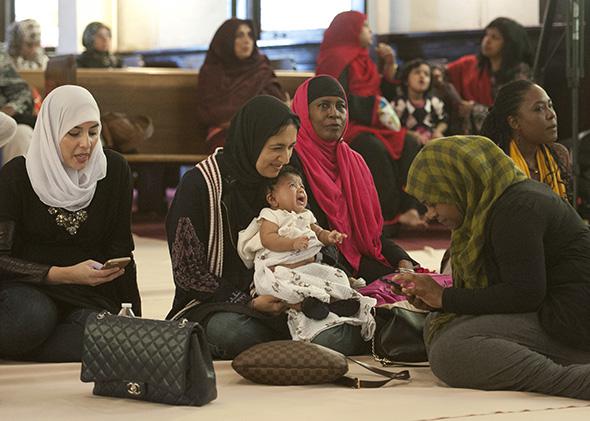The people who gathered on Friday evening for the first prayer service at Women’s Mosque of America didn’t need a 2011 study by the Islamic Society of North America to tell them what they already knew—and had experienced first hand: American mosques are not particularly welcoming to women.
The new L.A. Mosque, which caters exclusively to women and is believed to be the first of its kind in America (other similar spaces exist around the world in places like China and India), was created by comedy writer Hasna Maznavi and lawyer Sana Muttalib as a response to the various ways women are made to feel uncomfortable in many mosques—from separate and subpar entrances to the lack of leadership roles available to them. As Maznavi and Muttalib told the Huffington Post, the space will allow for female speakers, or khateeba (the feminine version of khateeb, the person who delivers the Friday sermon), who can address women’s issues from a female perspective. In most mosques, “women do not often get a chance to access the male imam for questions or discussions after prayer, because he is in the men’s section and is inaccessible until a later time.” By creating this space for conversation after services, they are hoping to facilitate a meaningful conversation that will speak to women’s concerns.
Maznavi and Muttalib are far from the first Muslim women to advocate for their place in the mosque. In 2012, Hind Makki started a Tumblr, Side Entrance, after a friend had a terrible experience in a hot and moldy women’s area in the basement of a mosque and tried to pray upstairs. The tag line of Side Entrance captures the scope of women’s experiences: “Photos from mosques around the world, showcasing women’s sacred spaces, in relation to men’s spaces. We show the beautiful, the adequate and the pathetic.” Makki told NPR in January that many men just don’t know what it’s like on the women’s side. “They just had no idea that this was somewhat typical of women’s experiences at a mosque—that you go to a mosque and you don’t see a dome; you don’t see the imam, certainly; you don’t see the architecture—you see a big wall in front of you.”
Experiences like this are of course not exclusive to mosques. I’ve had similar experiences in Orthodox Jewish synagogues where women and men sit separately, often with a divider between the two sections. Some of these experiences have been positive, like once, when there was no space for me and the men in attendance went out of their way to create one. But there was also the time when I was sent to a separate room with a small window covered with a curtain, and a synagogue where women had to go upstairs to another floor and look down through a hole.
Women’s participation in religion is very much in flux—in the past few years, female activists have been proactive about finding a place for themselves in Judaism, the Church of England, and Mormonism—and many have found that the first steps toward a solution involve isolating women and making spaces of their own. But that is never really the end goal. Creating separate but thriving women’s spaces is just one step toward what they hope will be equality in co-ed mosques, synagogues, and churches. As Maznavi told the Wall Street Journal, “We would love to not have to exist.”
